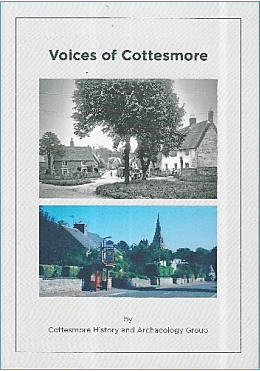Voices of Cottesmore
Published by Cottesmore History and Archaeology Group, 2020. ISBN 978-1-9996-9720-4
Available from the group via their website.(https://www.thelivingvillage.co.uk/)
This
Heritage
Lottery
Funded
paperback,
thirty-four
pages
perfect
bound
in
an
attractive
illustrated
edition,
is
based
on
the
transcripts
of
interviews
with
fifteen
Cottesmore
villagers
taken
by
the
group
over
recent
years
and
published
during
lockdown.
It
fulfils
the
intention
of the group to record the memories of older villagers for future generations.
This
is
something
all
local
history
groups
should
aspire
to
prioritise,
particularly
in
today's
fast
changing
local
communities.
The
Cottesmore
group
achieves
this
by
taking
extracts
from
the
literal
transcripts
of
interviews
and
arranging
them
under
headings
such
as
Family
Life,
Farming,
Travel
and
Pleasure,
and
Village
Life.
Each
small
chapter
is
arranged
under
smaller
subsections,
such
as
Ironstone,
Scrimping
and
Stricklands.
Paragraphs
under
these
headings
are
more
or
less
literal
transcripts
of
interviews.
They
are
anonymised
and
run
together
without any distinction between interviewees, which is quite confusing until one gets used to it.
There
is
much
good
and
useful
material
here
which
would
prove
of
interest
to
those
looking
into
the
social
history
of
Rutland
apart
from
those
just
solely
interested
in
Cottesmore
itself.
Although
some
of
the
detail
is
confusing
particularly
concerning
properties
since
changed
or
demolished,
the
reader
is
left
wishing
for
more.
However
the
group
have
made
a
good
start
in this short publication.
Some
of
the
illustrations
are
very
small
on
the
page
and
the
literal
transcription
of
some
of
the
comments
made
by
the
interviewees
does
not
always
make
the
text
flow
easily.
But
these
are
minor
criticisms
in
relation
to
a
publication
which
is
long
overdue
for
the
majority
of
Rutland's
communities
who
should
look
to
this
small
publication
to
see
how
it
could
be
done
for
their
own
village
and
the
benefits
in
recording memories before they are lost forever.
Dr Hilary Crowden

Researching Rutland
Copyright © Rutland Local History and Record Society. - All rights reserved
Registered Charity No 700273


Book Review



Researching Rutland
© Rutland Local History and Record Society
Registered Charity No 700273

Book Review
William Browne’s Town: The Stamford Hall Book 1465-1492
Stamford Survey Group in association with Stamford Town Council and
Stamford Civic Trust
Stamford is fortunate to have a Hall Book, a record of the council minutes
of the town. Until now it has remained in the town’s archives only to be
seen by historians with an appointment. With this transcript Alan Rogers
has made the first part of the Hall Book accessible to all and we are given
the opportunity to step back in time and discover what life was really like
in the fifteenth century. Future volumes are planned which will continue
the story of Stamford’s town affairs.
The book gives a remarkable insight into the lives of townspeople in
medieval England covering the years from 1465, shortly after the town’s
incorporation, until 1489 just after the death of William Browne. William
Browne was a very rich and important Merchant of the Staple. He
controlled the affairs of the town during this period, serving as Alderman
on several occasions. His legacy to Stamford is All Saints’ Church and
Browne’s Hospital.
As today, rules and regulations governed the lives of townsfolk. The
minutes record laws forbidding Sunday trading and fines for leaving
horses tied up in the wrong places on market days – as the editor
comments, ‘There were parking penalties even in medieval Stamford’. We
also find that there were designated places for dunghills and times when
animals could be brought into town. From this book we learn how law
and order was enforced and the punishments meted out to wrongdoers.
Perhaps the most interesting aspect of the volume is the tremendous
number of different trades pursued in the town. The wardens strictly
controlled the craftsmen to ensure the quality of goods and there was a
diversity of rules governing the guilds and the pageant of Corpus Christi.
Alan Rogers has had close links with Stamford and readers will no doubt
be familiar with his books The Medieval Buildings of Stamford
(Nottingham 1970), The Book of Stamford (Buckingham 1983) and, with
JS Hartley, The Religious Foundations of Medieval Stamford
(Nottingham 1974). He has also been closely involved with local history in
Rutland, most recently in Uppingham, inspiring and encouraging local
historians to record aspects of the history of that town.
For this volume Professor Rogers has written an excellent introduction
including the insight he has gained about the role of William Browne in
making the transcript. He also adds useful comments throughout the
volume and there is an excellent index. It is a shame that the Editorial
Conventions are not at the front of the book and a glossary would have
been useful for those less familiar with the legal terms of the medieval
period. Do not however be deterred by the plain cover: inside it is a
fascinating record not just for people in Stamford but for anyone
interested in town life in the Middle Ages. It is a book to dip into, and read
aloud it comes to life. It certainly merits a place on the bookshelf of
anyone interested in history.
Jean Orpin







